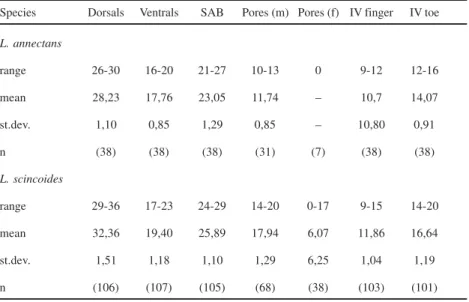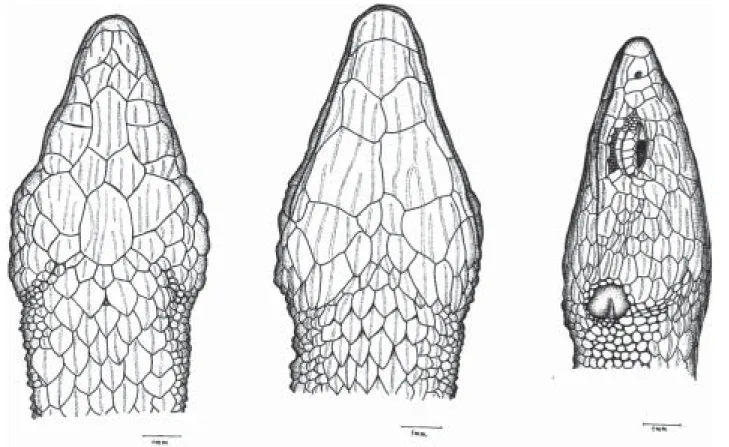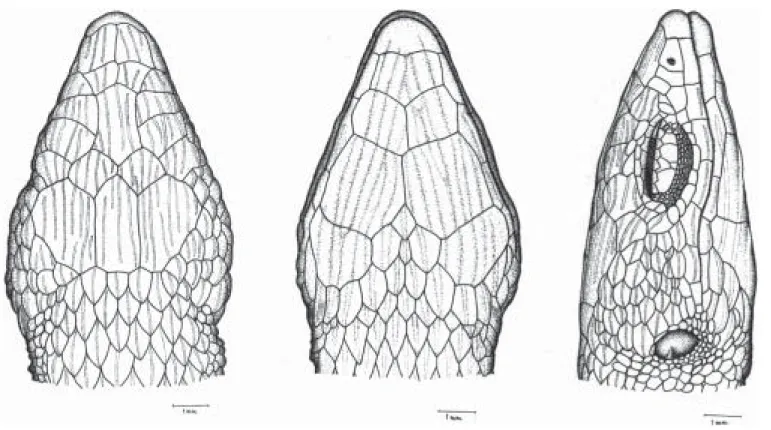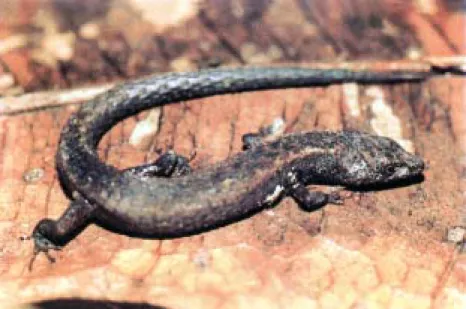MUSEU DE ZOOLOGIA DA UNIVERSIDADE DE SÃO PAULO
ISSN 0031-1049
PAPÉIS AVULSOSDE ZOOL., S. PAULO 42(5):103-117 14.VI.2002
1. Universidade de São Paulo, Instituto de Biociências, Departamento de Zoologia, Caixa Postal 11.461, CEP 05422-970, São Paulo, Brazil
2. Museu de Zoologia, Universidade de São Paulo, Caixa Postal 42.594, CEP 04299-970, São Paulo, Brazil
3. Universidade de São Paulo, Instituto de Biociências, Departamento de Ecologia, Caixa Postal 11.461, CEP 05422-970, São Paulo, Brazil
Trabalho recebido para publicação em 17.VIII.2000 e aceito em 17.IV.2001.
A LARGE SAMPLE OF LEPOSOMA (SQUAMATA,
GYMNOPHTHALMIDAE) FROM THE ATLANTIC FORESTS OF
BAHIA, THE STATUS OF LEPOSOMA ANNECTANS RUIBAL, 1952,
AND NOTES ON CONSERVATION
MIGUEL TREFAUT RODRIGUES1,2 MARIANNA DIXO3 GUSTAVO MATTOS ACCACIO1
ABSTRACT
Leposoma annectans Ruibal, 1952 is resurrected from synonymy with
and L. scincoides suggests that a temperature sex determination mechanism (TSD) could be the mode of sex determination in these species. Populations of reptiles with TSD mechanisms may be more prone to extinction due to skewed sex ratios caused by increased temperatures in disturbed tropical forests.
KEYWORDS: Leposoma annectans; L. nanodactylus, L. scincoides, Squamata,
Gymnophthalmidae.
INTRODUCTION
Leposoma annectans Ruibal, 1952, was described from a female
specimen in the context of a revisionary paper on some genera of South American gymnophthalmids (Ruibal, 1952). The holotype and only specimen known (DZ 790B; now MZUSP 7693) collected from “Baia, State of Bahia, Brazil”, was briefly diagnosed from congeneric species. Ruibal admitted its resemblance with Leposoma scincoides, at the time the only other Atlantic Forest species of Leposoma, but distinguished it from that species by its enlarged interparietal
and by the presence of a small scale separating the third pair of postmentals from infralabials. Since then, there were no reports of additional specimens.
In a paper describing a new species of Leposoma from a relictual forest
in northeastern Brazil (Leposoma baturitensis), the status of Leposoma annectans was reevaluated (Rodrigues and Borges, 1997). After comparing the
holotype of Leposoma annectans against a large series of specimens of Leposoma scincoides, Rodrigues and Borges concluded that the two taxa were
identical and considered them synonymous. That decision was based on the absence of specimens showing the diagnostic features of Leposoma annectans.
The occasional presence of a small scale separating the third pair of chinshields from infralabials in some examples of L. scincoides and the presence of an
enlarged interparietal in some specimens provided additional support to synonymize both forms. Those features were sometimes present asymmetrically in the same individual. In a paper, describing another new Leposoma from the
Atlantic Forests of State of Bahia (Leposomananodactylus), no further reference
was made to L. annectans (Rodrigues, 1997).
Recently, the RestaUna project was designed to investigate the comparative response of several biological groups facing forest fragmentation in the Northeastern Atlantic Rainforests. The core area selected for intensive field work is the remaining fragments of Atlantic forest near Una in of State of Bahia. As a result of an ongoing survey of the herpetofauna, we obtained a sample of 166 Leposoma in pitfall traps. Although at first we considered all
specimens to be examples of Leposoma scincoides, a detailed study revealed
to Leposoma nanodactylus, representing the first report of specimens since the
original description (Rodrigues, 1977). Regarding the two other species, one was recognized as Leposoma scincoides, but the other, to our surprise was
composed of lizards presenting consistently most of the distinguishing features attributed by Ruibal to Leposoma annectans. As the two forms were obtained
syntopically along with the specimens of L. nanodactylus and they maintain
their distinctive features, we herein revalidate the species status of Leposoma annectans, redescribe it and comment on potential conservation implications.
MATERIAL
Specimens from Resta Una project examined
Leposoma annectans: Brazil: Bahia: Una: MZUSP 87.792 87.804; 87.851
-87.874; 87.958, M. Dixo and G. Accacio col.
Leposoma nanodactylus: Brazil: Bahia: Una: MZUSP 87.955 - 87.957, M.
Dixo and G. Accacio col.
Leposoma scincoides: Brasil: Bahia: Una: MZUSP 87.805 87.050; 87.875
-87.954.
Additional specimens examined
Leposoma annectans. Brazil: Bahia: “Baia”: MZUSP 7693.
Leposoma baturitensis. Brazil: Ceará: Serra de Baturité: Pacoti (Sítio Barbosa):
MZUSP 79.378; Pacoti (Sítio São Gonçalo do Freire): MZUSP 79.379.
Leposoma guianense. Brazil: Amapá: Serra do Navio: MZUSP 3493, 7690,
17.005, 17.544-17.545, 78.174, 78177, 78.183, 78.186, 78.189-78.190; Vila Nova: MZUSP 78.176. Pará: As Pedras: MZUSP 53.707-53.719; Oriximiná:
MZUSP 12.538, 13.189, 24.537, 31.387, 31.664-31.665, 35.321-35.333; Poção: MZUSP 77.483; Taboleiro Leonardo (Rio Trombetas): MZUSP 53.798-53.719, 54.359, 54.469-54.470; Uruá (Rio Tapajós): MZUSP 52.519, 52.521, 53.643.
Leposomananodactylus. Brazil: Bahia: São José do Macuco (Fazenda Unacau):
MZUSP 66.474.
Leposoma parietale. Ecuador: Pastaza: Rio Bobonaza: MZUSP 9277. Peru: Loreto: Estirón: MZUSP 13.931-13.933; Moropón: MZUSP 28.292-28.294,
28.303, 39.436; Yanamono: MZUSP 28.352.
Leposoma percarinatum. Brazil: Amazonas: Manaus (INPA/WWF reserves):
MZUSP 66.146-66.147, 66.350. Pará: Aveiro: MZUSP 19.998; Cachoeira do
Limão (Rio Tapajós): MZUSP 53686; Taboleiro Leonardo (Rio Trombetas): MZUSP 52.617, 53.809-53.812; Uruá (Rio Tapajós): MZUSP 52.520; Vai-quem-Quer: 78.216-78.217. Roraima: Apiaú: MZUSP 66.971-66.972, 68.878; Ilha
Leposoma oswaldoi. Brazil: Amazonas: Acanauí: MZUSP 47.212; Lago Miuá:
MZUSP 17.314. Rondônia: Nova Brasília: MZUSP 62.330; Nova Colina:
MZUSP 62.168; Nova Esperança: MZUSP 62.336; Santa Bárbara: MZUSP 64.606-64.612.
Leposoma rugiceps. Colombia: Madalena: Los Cocos: MZUSP 55.686.
Panama: Gatun (Canal Zone): MZUSP 49.178.
Leposoma scincoides. Brazil: Bahia: Cumuruxatiba: MZUSP 59.191; Ilhéus:
MZUSP 8982, 57.287; Itabuna: MZUSP 78.715-78.717, 78.795-78.802. Porto Seguro: MZUSP 79.545, 79.564; 15 Km N Porto Seguro: MZUSP 66.349; São José do Macuco (Fazenda Unacau): MZUSP 66.464-66.473; Uruçuca: MZUSP 13.444-13.445. EspíritoSanto: Linhares: MZUSP 39.580, 57.285-57.286; Porto
Cachoeiro: MZUSP 3002; Santa Tereza: MZUSP 17.440, 57.252, 57.288-57.289, 57.292, 79.565.
Leposoma southi. Costa Rica: Suretka (Dixaola river): MZUSP 49.175.
Leposoma annectans Ruibal, 1952
Description of the new specimens (Fig. 1).Rostral broad, wider than
the first smallest and longer than wide; the third the largest, squarish, much larger than second and fourth that are subrectangular and wider than long; all contacting superciliaries. Nasal above first supralabial, large, longer than wide, entire, with the nostril in the center; ventral margin slightly rounded, dorsal margin straight. Loreal posterior to nasal, narrow and diagonally oriented; anterior to frenocular; the last followed by a series of 4 or 5 infraorbital elongate granules. Five supralabials, first longest, fifth highest, third and fourth eye; fifth supralabial followed by a scale approximately as large as the last supralabial and separated from the tympanum by 3 much smaller scales. Four or five superciliaries, first largest, larger than or as large as first supraocular, expanded on lateral surface of head. Eyelid with semitransparent disc formed by 3-4 scales. Temporal region covered with strongly keeled juxtaposed scales that are smaller between the area delimited by the tympanum and much larger in the occipito-temporal region around parietals. Lateral surface of neck with conical and juxtaposed, sometimes keeled granules, arranged in irregularly transverse rows. Ear opening bordered by a series of very small, smooth, granules; tympanum distinct, subovoid. All scales of the top of head with sharp and irregularly longitudinal striations.
Mental broad, wider than long. Postmental single. First pair of genials smallest in broad contact at middline, second largest, in contact anteriorly, both in contact with infralabials. Third pair of genials the smallest, approximately as long as wide, separated medially by a series of elongate scutes and from the infralabials by an enlarged and elongate scute. Mental, postmental and genials strongly marked with sharp longitudinal striations. Infralabials five; second and third largest. Scales immediately posterior and lateral to third pair of genials elongate, juxtaposed, strongly keeled or striated. From there on they gradually grade into lanceolate, imbricate and keeled gulars. Gulars in 9-11 transverse rows, lanceolate, imbricate, strongly keeled. Collar fold indistinct.
Dorsal scales large, strongly keeled, mucronate, imbricate, becoming laterally juxtaposed at midbody, in 26-30 regular transverse rows between interparietal and posterior level of hind limbs. Lateral scales resemble dorsals; grade into ventrals except for an area with small, flat, almost smooth and juxtaposed scutes near groin and a region with small and conical granules around arm level. Scales around midbody 21-27. Ventrals leaf-shaped, keeled, mucronate, imbricate, in 16-20 regular transverse and diagonal rows from interbrachials (included) to preanals. Posterior margin of the vent with five scales; central and paramedial scales the largest. Total pores (preanal plus femoral) 10-12 in males (4 preanal). Pores absent in females.
Limb scales keeled and imbricate, except on ventral surface of brachium and on posterior surface of thigh which are mostly subimbricate or juxtaposed, sometimes granular. Palmar and plantar surfaces with small, conical granules. Subdigital lamellae mostly double, 9-12 on Finger IV and 12-16 on Toe IV. Fingers and toes clawed, with the following relative sizes: 1 < 2 = 5< 3 <4 and 1 < 2 < 5 < 3 < 4, respectively.
Dorsal surface of body and tail light brown with irregular dark brown or black spots one scale wide. An inconspicuous dorsolateral light stripe one-half to one scale wide running from midbody level toward the ear level, their anteriormost parts converging to occipital region. Between stripes a double series of irregularly disposed black spots extends from the occipital region to the base of tail. Flanks and lateral surface of tail slightly darker than back with a few small light spots more conspicuous on neck. Dorsal and lateral surface of head light brown with scattered dark brown reticulation. Ventral parts of head, body and tail yellowish cream, immaculate. Limbs dark brown dorsally, mottled with yellow; ventrally yellowish cream, immaculate, like for the ventral parts of body and tail.
COMPARISONSWITH LEPOSOMASCINCOIDES
(Figs 1 and 2)
Leposoma annectans and Leposoma scincoides are the only Atlantic
Forest Leposoma presenting a longitudinally divided frontonasal and highly
striated scales on head. The two species can be separated by the following list of characters. Except when noted, differences refers to all specimens of L. scincoides examined.
1) Leposoma annectans presents a posteriorly enlarged interparietal with lateral
margins slightly concave and divergent; in L. scincoides the interparietal is
not enlarged posteriorly and its lateral margins are almost parallel. 2) Leposoma annectans has parietals as long as wide and shorter than the
interparietal; in L.scincoides the parietals are longer than wide and as the
long as the interparietal.
3) Leposoma annectans has a small scale separating the third pair of chinshields
from the infralabials; in scincoides no such scale exists and the third pair of
chinshields contacts the infralabials.
4) Leposoma annectans has a very large and almost quadrangular third
supraocular; in scincoides the third supraocular is clearly wider than long
having approximately the same size as the second supraocular.
5) Leposoma annectans presents conspicuous sharp striations on the scales of
the ventral part of head; in scincoides these scales are almost smooth.
6) Leposoma annectans is more dark colored and has more irregular dorsal
7) Leposoma annectans has a shorter body length and relative tail length when
compared with scincoides (Fig. 4).
8) In Leposoma annectans, femoral and preanal pores are restricted to males,
and are absent in females; in females of scincoides pores are present or
absent.
9) Leposoma annectans additionally differs from L. scincoides in having a
lower number of dorsal and ventral scales, lower counts of scales around midbody, a lower number of fourth finger and fourth toe infradigital lamellae and a lower number of total femoral pores. Table 1 summarizes these data for the sample obtained syntopically at Una, State of Bahia. Differences between the two species in number of dorsal and ventral scales, scales around body, total number of pores and number of fourth finger and fourth toe lamellae are all significant (t-test and Kruskall-Wallis test; P<0.01). Except for femoral pores, there are no sexual differences in the caracters studied for Leposoma annectans (t-test; P<0.01). The same is true for Leposoma scincoides except that females of this species have slightly higher counts of
ventrals and scales around body than males (t-test and Kruskal-Wallis test; P>0.05).
COMPARISONSWITHOTHER LEPOSOMA
The twelve species presently included in the genus Leposoma can be
separated in two clearly distinctive groups: parietale and scincoides (Rodrigues,
1997). Species of the scincoides group (scincoides, nanodactylus and baturitensis) are restricted to eastern Brazil and have elongate dorsal scales
and lanceolate ventrals that are arranged in diagonal rather than in longitudinal rows. In the more diverse parietale group (9 species) ranging from Amazonia
to Costa Rica, dorsal scales are wider and shorter, and ventral scales are arranged in regular longitudinal rows. Leposomaannectans is a member of the scincoides
group as it has lanceolate ventrals arranged in diagonal rather than in regular longitudinal rows. In the scincoides group it differs from Leposoma nanodactylus and L. baturitensis by characters 1-5 referred above, by having a
longitudinally divided frontonasal (single in nanodactylus and baturitensis),
and by presenting the dorsal and ventral scales of the head heavily striated (weakly striated or smooth in nanodactylus and baturitensis). From Leposoma baturitensis it additionally differs by the number of IV toe lamellae (12-16;
16-18 in baturitensis), total pores (10-13; 13-15 in baturitensis) and color
pattern.
Three specimens of Leposoma nanodactylus, the first record since the
and agree perfectly with the original description. Even characters supposed to be variable like the presence of five supraoculars, the ventrolateral black pigmentation and the arrangement of preanal scales are identical to the conditions reported for the type. The new meristic data, combined with those reported for the holotype, provides additional characters to diagnose Leposoma nanodactylus
from Leposoma annectans (characters from the latter in parenthesis): dorsal
scales: 31-33 (26-30); ventral scales: 18-20 (16-20); scales around body: 27-31 (21-27); IV finger lamellae: 7-8 (9-12); IV toe lamellae: 10-12 (12-16); total pores: 10 (10-13).
Leposoma annectans is also unique in that the majority of specimens
have an azygous scale between the longitudinally divided frontonasal and the prefrontals. The presence of supernumerary scales between frontonasal and prefrontal, although rare, does occur in other gymnophthalmids. It was described as an occasional occurrence in some species of Neusticurus, and recognized as
diagnostic in Amapasaurus, a poorly known monotypic genus related to Leposoma.
DISTRIBUTIONAND ECOLOGY
The Atlantic rainforests of eastern Bahia are among the top five threatened hotspots of the world (Mittermeier and Mittermeier, 1997). Enormous amounts of forests have been cut down in the last decades for timber and farming. In 1980, an area of 11.400 ha of remaining forests near Una was declared preserved by the government as the Reserva Biológica de Una (15°10’S, 39°03’W). The relief is hilly with some of the valleys dissected by medium size to small streams. Annual precipitation reaches 2000 mm without conspicuous seasonality. Primary forest is composed of high trees, reaching up to 40 m where palms are especially abundant and a characteristic leaf litter is present. The area is also characterized by a high diversity of bromeliads and ferns. Most of the forest surrounding the Una reserve has been selectively cut to accommodate cacao plantations or other crops or cleared for cattle ranching. A few fragments of primary forest remain. In the cacao groves, large and emergent trees (up to 30 m tall and over approximately 50 cm diameter at breast height) have been preserved to shade the understory cacao plants. In these characteristic sheltered cacao groves (cabruca, locally), leaf litter is abundant and formed predominantly by cacao leaves. Despite their high degree of disturbance compared to primary forests, cabrucas provide shelter and humidity for forest animals, apparently protecting them from extirpation in open areas (Araujo et al., 1998).
forest fragments, secondary forests and, cacao groves. Table 2 shows that
Leposoma scincoides and Leposoma annectans were more frequently found
in disturbed habitats, specially in cacao groves where their frequency was highest. The sample size of L. nanodactylus is too small to discern habitat
preference but two of the three specimens collected along the edge of a forest fragment. A Chi-square test shows no association between habitat categories and species or sex (P>0.05), nor between habitat categories and sex within each species (P>0.05).
The abundance and preference of Leposoma for disturbed habitats in
the Atlantic Forests of State of Bahia is not surprising. In October 1986, at São José do Macuco (15°09’ S, 39°18’ W) in the same general area of the present study, a collection of Leposoma was also obtained. Of the thirteen specimens
collected, one was a male and became the holotype of Leposoma nanodactylus,
two specimens (a male and a juvenile) remain unidentified, and 10 specimens (5 males and 5 females) were L. scincoides (Rodrigues, 1997). At the time the
area had been recently prepared for cacao farming and large patches of primary forest interdigited with the groves. Although leposomas were spotted and obtained by hand in both habitats, they were definitively more abundant in the cacao groves than in the primary forest.
The surprise was the sex-ratio of our collection. Table 3 shows for the three species the number of males and females obtained in the pitfall traps. The astonishingly high number of males and the disproportionatly low number of females is puzzling. This sample strongly differs from the balanced sex-ratio obtained in the 1986 sample. As the sampling covers two different periods of year, the number of trapped females is probably not associated with seasonal changes in reproductive behavior. Numbers of females are surprisingly low both in Leposoma scincoides and Leposoma annectans. The same skewed
sex-ratio might also be ocurring in the rare Leposoma nanodactylus, from which
only three males were collected. Curiously, the species was previously known only from a male specimen. Unless females are strikingly different from males in terms of habitat selection which in turn could affect their capture rate in pitfalls, there must be another reason for such a skewed sex-ratio. Also, the hypothesis should explain the same phenomenon in two and possibly three syntopic species.
Sex determination by temperature could explain the skewed sex ratio. In species of Leposoma studied cytogenetically (scincoides, oswaldoi, and guianense), there are no heteromorphic sex chromosomes suggesting a
chromosome mechanism of sex determination (Pellegrino, et al., 1999). No
data on temperature sex determination (TSD) exists for gymnophthalmids, although it has been described in Lacertidae (Viets et al., 1994), which are the
Table 1. Range, mean, standard deviation (st.dev.) and sample size (n) for number of dorsal and ventral scales, scales around body (SAB), total number of pores for males (m) and females (f), IV Finger, and IV Toe infradigital lamelae of Leposoma annectans and Leposoma scincoides obtained sympatrically at Una, State of Bahia, Brazil.
Species Dorsals Ventrals SAB Pores (m) Pores (f) IV finger IV toe
L. annectans
range 26-30 16-20 21-27 10-13 0 9-12 12-16
mean 28,23 17,76 23,05 11,74 – 10,7 14,07
st.dev. 1,10 0,85 1,29 0,85 – 10,80 0,91
n (38) (38) (38) (31) (7) (38) (38)
L. scincoides
range 29-36 17-23 24-29 14-20 0-17 9-15 14-20
mean 32,36 19,40 25,89 17,94 6,07 11,86 16,64
st.dev. 1,51 1,18 1,10 1,29 6,25 1,04 1,19
n (106) (107) (105) (68) (38) (103) (101)
Table 2. Number of specimens of L. annectans, L. nanodactylus, and L. scincoides collected with pitfall traps in different habitats at Una, State of Bahia between January and November 1999. Sampling effort was the same in all habitats.
Species L. annectans L. nanodnctylu L. scincoide total
primary forest (core) 3 0 2 5
primary forest (border) 4 0 7 11
forest fragment (core) 4 1 11 16
forest fragment (border) 3 2 18 23
secondary forest (“Capoeira”) 8 0 17 25
cacao groves (“Cabruca”) 14 0 63 77
Table 3. Sex frequencies in samples of Leposoma scincoides, L. annectans and L. nanodactylus collected at Una, Bahia with pitfall trapping.
Species January-February October-November
1999 1999
Males Females Males Females
L. annectans 10 4 20 3
L. scincoides 28 18 58 22
L. nanodactylus 0 0 3 0
temperatures and the range of temperatures producing both sexes is very small (pattern Ib, Bull (1983), Lang and Andrews, 1994; Viets et al., 1994)).
Temperatures in cacao groves, forest edge, clearings, secondary forests, and small forest fragments are probably higher than mean temperatures in primary forests. Therefore, we suggest that forest disturbance may threaten
Leposoma populations by causing elevation of mean ambient temperature in
forest fragments which, in turn, may produce sex ratios highly skewed towards males.
If TSD mechanism exists in Leposoma, the natural distribution of edge
and treefall gaps in primary forest play a role in maintaining balanced sex-ratios. However, the range of mean temperature distribution in small forest fragments and cabruca may be significantly altered.
ACKNOWLEDGMENTS
We thank Fundação de Amparo à Pesquisa do Estado de São Paulo (FAPESP), Conselho Nacional de Desenvolvimento Científico e Tecnológico (CNPq) and Financiadora de Estudos e Projetos (FINEP) for support. RestaUna project is funded by PROBIO (MMA), CNPq, GEF and BIRD. Barbara Zimmerman and Katia Pellegrino reviewed the manuscript.
REFERENCES
Papéis
A
vulsos de Zoologia
115
Figure 3. Leposoma annectans from Una, State of Bahia, Brazil.
Bull, J. J. 1983. Evolution of sex determination mechanisms. xx + 316 pp. Menlo Park, Calif.: Benjamin/Cummings Pub. Co., Advanced Book Program.
Lang, J. W. and H. V. Andrews. 1994. Temperature-dependent sex determination in crocodilians. Journ. Exp. Zool., 270: 28-44.
Mittermeier, R. A. & C.G. Mittermeier. 1997. Megadiversity. Earth’s biologically wealthiest nations. CEMEX. Quebecor Printing, Canada. 501pp.
Pellegrino, K.C. M., M. T. Rodrigues and Y. Yonenaga-Yassuda. 1999. Chromosomal evolution in the Brazilian lizards of the genus Leposoma (Squamata, Gymnophthalmidae) from Amazon and Atlantic rain forests: banding patterns and FISH of telomeric sequences. Hereditas 131. 15-21.
Rodrigues, M. T. 1997. A new species of Leposoma (Squamata: Gymnophthalmidae) from the atlantic forest of Brazil. Herpetologica 53: 383-389.
Rodrigues, M. T. & D. M. Borges, 1997. A new species of Leposoma (Squamata: Gymnophthalmidae) from a relictual forest in semiarid northeastern Brazil. Herpetologica 53: 1-6.
Ruibal, R. 1952. Revisionary studies of some South American Teiidae. Bull. Mus. Comp. Zool. 106: 477-529.
Viets, B. E., M. A. Ewert, L. G. Talent & C. E. Nelson. 1994. Sex-determination mechanisms in squamate reptiles. Jour. Exp. Zool., 270: 45-56.
CREDENCIAMENTO E APOIO FINANCEIRO DO




